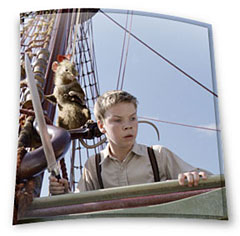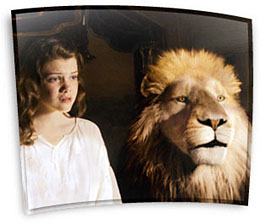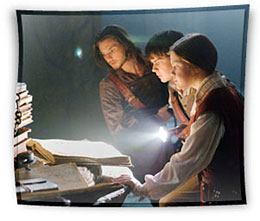
In response to a request from his editor, C. S. Lewis once authored a very short piece to explain how he came to write The Lion, the Witch, and the Wardrobe. He reported that it “all began with a picture of a Faun carrying an umbrella and parcels in a snowy wood. This picture,” he wrote, “had been in my mind since I was about sixteen.”1 (He actually wrote the book more than 30 years later, and it took Hollywood more than 40 years after that to deem it worthy of serious production.)
In a sense, The Voyage of the Dawn Treader, the third in Lewis’s seven-volume Chronicles of Narnia series—and the third in the film series—also begins with a picture. The two elder Pevensie children—Susan and Peter—do not appear in the book or the film. However, the two younger children—Lucy and Edmund—are visiting in the home of an obnoxious cousin aptly named Eustace Clarence Scrubb.
 According to the book on which the film is based, Eustace has grown up in a home that is markedly different from that of Lucy and Edmund. He has been receiving a so-called “progressive” education. He and his parents “were vegetarians, non-smokers, and tee-totallers.”2 And Eustace’s taste in reading was quite decided: “He liked books if they were books of information.”3
According to the book on which the film is based, Eustace has grown up in a home that is markedly different from that of Lucy and Edmund. He has been receiving a so-called “progressive” education. He and his parents “were vegetarians, non-smokers, and tee-totallers.”2 And Eustace’s taste in reading was quite decided: “He liked books if they were books of information.”3
Since the dawn of the enlightenment about three centuries ago, even Christians have adopted an almost robotic emphasis on the expository over the narrative. Rigid reason, empirical fact, and measurable information have taken precedence over any aesthetic form. Yet, as theologian Stanley Grenz points out, “Our humanity does not consist solely in our cognitive dimension. We are intellectual beings, but we amount to more than just Aristotle’s ‘rational animal.’ . . . Fundamental reality of God transcends human rationality.”4
In The Voyage of the Dawn Treader, the picture in question, on the otherwise bare wall of a guest room, is a painting of a ship sailing over billowing waves directly at the viewer, and Lucy and Edmund are commenting on it. They are remarking how much the ship looks like a Narnian vessel and how it appears as if it is really moving over the waves. Eustace, a scornful unbeliever in all the stories the Pevensies have told about Narnia, is scoffing till he himself begins to experience something peculiar about the picture too. He moves to take the painting down from the wall, but then, incredibly, seawater begins to cascade from the picture, quickly filling the guest room, and the three children are suddenly swept away, transported to Narnia, this time through a picture rather than a wardrobe.
 At this harrowing moment, utterly awash in the blue deep, they would all have surely drowned at sea, but the ship, The Dawn Treader, pulls alongside and rescues them. The commander of the ship is none other than Caspian X, the same individual as Prince Caspian in the second film of the Narnia series, now king, and the ship is crewed by various characters and creatures whom Lucy and Edmund have encountered in the two earlier tales of Narnia. Many years in Narnian time have ensued since Lucy and Edmond were there last. Yet they feel very much at home, ready for a new adventure. Eustace is in for a long ride. They soon learn that they have just been rescued on a voyage that is to become an episodic adventure to “the end of the world.”
At this harrowing moment, utterly awash in the blue deep, they would all have surely drowned at sea, but the ship, The Dawn Treader, pulls alongside and rescues them. The commander of the ship is none other than Caspian X, the same individual as Prince Caspian in the second film of the Narnia series, now king, and the ship is crewed by various characters and creatures whom Lucy and Edmund have encountered in the two earlier tales of Narnia. Many years in Narnian time have ensued since Lucy and Edmond were there last. Yet they feel very much at home, ready for a new adventure. Eustace is in for a long ride. They soon learn that they have just been rescued on a voyage that is to become an episodic adventure to “the end of the world.”
In Dawn Treader, “the end of the world,” as in the third segment of the Pirates of the Caribbean film trilogy (“world’s end”), is physical, geographical—not temporal. It describes a place, not a time. In both Pirates and Dawn Treader are images and ideas reminiscent of mythical times, when the world was considered to be flat and there was the threat of tumbling off the edge of the earth into oblivion. There was no aspect of a hereafter in this context.
Today “the end of the world” has more of a temporal—and spiritual—nature. It has come to suggest the end of time, when some kind of cataclysmic event, some singularity, brings about the conclusion of human history as we know it. Even many today who have little or no belief in spirituality find themselves facing the unsettling inevitability of an ultimate finality.
This has given rise to the current cultural fascination in film and literature depicting some kind of end—or at least a wrenching shift—in human existence. A recent issue of Wired Magazine included a quick-read synopsis of the four basic apocalyptic scenarios that appear in current media: rampant viruses/exploding nukes (The Road, The Book of Eli); natural disaster (Solarbabies, Day After Tomorrow); alien invasion (War of the Worlds, Independence Day); and authoritarian dystopia (Blade Runner, Logan’s Run).5
 In all of these scenarios, humankind somehow escapes utter annihilation. After all, who would be interested in watching a film in which cockroaches are the only surviving carbon-based life form? (Come to think of it, this is the scenario of Disney’s 2008 Pixar animation: Wall•E.) But there is never any mention of the Second Coming, no salvation through the Son of God as it is described biblically.
In all of these scenarios, humankind somehow escapes utter annihilation. After all, who would be interested in watching a film in which cockroaches are the only surviving carbon-based life form? (Come to think of it, this is the scenario of Disney’s 2008 Pixar animation: Wall•E.) But there is never any mention of the Second Coming, no salvation through the Son of God as it is described biblically.
The Pevensies are perfectly comfortable with a worldview that transcends time; Eustace, not so much. In fact, a great portion of the remainder of the narrative addresses the beginning of a long and difficult odyssey of spiritual transformation for Eustace, from a determined disbeliever in what is clearly going on all around him to the painful process that starts when “he began to wonder if he himself had been such a nice person as he had always supposed.”6
This, of course, is a very basic spiritual question. Yet it is counterintuitive to a widespread current worldview that a human being is inherently good, that humanity is moving inevitably toward a godlike state. From this viewpoint, humankind is its own savior.
Eustace had never imagined anything except his own superiority to all around him. In his own mind, he considered himself the arbiter of truth. And his lack of imagination is what lay at the center of the difference between him and his Pevensie cousins. Within moments of their rescue aboard ship, Eustace demands to know, “Where . . . am I?”
“You’re aboard the Dawn Treader,” answers a hulking Minotaur twice his size. And Eustace promptly collapses in a dead faint.
In point of fact, imagination is central to C. S. Lewis’s theology, especially as it offers opportunity to express truth. As Christian culture critic Janine Langan writes, “We tend to think of the imagination as ‘ice cream on the cake’—as flight, fancy, distraction, decoration. My contention is that there is nothing more fundamental than the imagination, and that our loss of respect for it is directly linked to religious apathy.”7 Lewis would surely have agreed.
 If we are created in the image of God, would that not include having an imagination? Were we not created first in the imagination of God? Could God have created the earth without imagining it first?
If we are created in the image of God, would that not include having an imagination? Were we not created first in the imagination of God? Could God have created the earth without imagining it first?
Eustace wakens to find himself, incontrovertibly, in a spiritual world beyond his imagination, whose existence he has always denied. For him now the spiritual has become experiential. And if there is anything that C. S. Lewis has accomplished in his work, it is that the human experience is both material and spiritual. “Humans,” he wrote, “are amphibians—half spirit and half animal. . . . As spirits they belong to the eternal world, but as animals they inhabit time.”8 This sounds very much like the seventh fundamental belief of Seventh-day Adventists: Each human being “is an indivisible unity of body, mind, and spirit.”9
And it was a concept—especially among mid-twentieth-century scholars—that was quite revolutionary. By now, of course, half a century later, the pendulum has swung decidedly back toward an increasing interest in spirituality, both in scholarship and in the everyday world. It pervades the media and the wider culture.
In such stories as The Chronicles of Narnia and others of his works, C. S. Lewis anticipated this worldview. He endeavored to express the absolute truth of Christianity to a stubbornly unbelieving world. Certainly a significant portion of his works represent Christianity in effective expository fashion. But he also did so in forms that, in his own words, “may say best what’s to be said.”10
_______________
1. C. S. Lewis, Of Other Worlds (New York: Harcourt, Inc., 1966), p. 42.
2. The Voyage of the Dawn Treader, in The Chronicles of Narnia (New York: HarperCollins, 1952), p. 425.
3. Ibid.
4. Stanley J. Grenz, A Primer on Postmodernism (Grand Rapids, Mich.: Eerdmans, 1996), pp. 169, 170(?)
5. Wired Magazine, October 2010, p. 107.
6. Ibid., p. 466.
7. Janine Langan, “The Christian Imagination,” in The Christian Imagination (Colorado Springs, Colo.: WaterBrook Press, 2002), p. 63
8. C. S. Lewis, The Screwtape Letters (New York: HarperCollins, 1996), p. 37.
9. Fundamental Belief no. 7.
10. C. S. Lewis, Of Other Worlds, ibid., p. 35.
_______________
Gary Swanson is associate director of the General Conference Sabbath School and Personal Ministries Department.